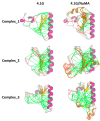Extreme Fuzziness: Direct Interactions between Two IDPs
- PMID: 30813629
- PMCID: PMC6468500
- DOI: 10.3390/biom9030081
Extreme Fuzziness: Direct Interactions between Two IDPs
Abstract
Protein interactions involving intrinsically disordered proteins (IDPs) greatly extend the range of binding mechanisms available to proteins. In interactions employing coupled folding and binding, IDPs undergo disorder-to-order transitions to form a complex with a well-defined structure. In many other cases, IDPs retain structural plasticity in the final complexes, which have been defined as the fuzzy complexes. While a large number of fuzzy complexes have been characterized with variety of fuzzy patterns, many of the interactions are between an IDP and a structured protein. Thus, whether two IDPs can interact directly to form a fuzzy complex without disorder-to-order transition remains an open question. Recently, two studies of interactions between IDPs (4.1G-CTD/NuMA and H1/ProTα) have found a definite answer to this question. Detailed characterizations combined with nuclear magnetic resonance (NMR), single-molecule Förster resonance energy transfer (smFRET) and molecular dynamics (MD) simulation demonstrate that direct interactions between these two pairs of IDPs do form fuzzy complexes while retaining the conformational dynamics of the isolated proteins, which we name as the extremely fuzzy complexes. Extreme fuzziness completes the full spectrum of protein-protein interaction modes, suggesting that a more generalized model beyond existing binding mechanisms is required. Previous models of protein interaction could be applicable to some aspects of the extremely fuzzy interactions, but in more general sense, the distinction between native and nonnative contacts, which was used to understand protein folding and binding, becomes obscure. Exploring the phenomenon of extreme fuzziness may shed new light on molecular recognition and drug design.
Keywords: binding mechanism; extremely fuzzy complex; intrinsic disordered protein; protein interaction.
Conflict of interest statement
The authors declare no conflict of interest.
Figures



Similar articles
-
The Dynamic Multisite Interactions between Two Intrinsically Disordered Proteins.Angew Chem Int Ed Engl. 2017 Jun 19;56(26):7515-7519. doi: 10.1002/anie.201701883. Epub 2017 May 24. Angew Chem Int Ed Engl. 2017. PMID: 28493424
-
The sequence-ensemble relationship in fuzzy protein complexes.Proc Natl Acad Sci U S A. 2021 Sep 14;118(37):e2020562118. doi: 10.1073/pnas.2020562118. Proc Natl Acad Sci U S A. 2021. PMID: 34504009 Free PMC article.
-
Deciphering the Dynamic Interaction Profile of an Intrinsically Disordered Protein by NMR Exchange Spectroscopy.J Am Chem Soc. 2018 Jan 24;140(3):1148-1158. doi: 10.1021/jacs.7b12407. Epub 2018 Jan 11. J Am Chem Soc. 2018. PMID: 29276882
-
Theoretical perspectives on nonnative interactions and intrinsic disorder in protein folding and binding.Curr Opin Struct Biol. 2015 Feb;30:32-42. doi: 10.1016/j.sbi.2014.12.002. Epub 2014 Dec 24. Curr Opin Struct Biol. 2015. PMID: 25544254 Review.
-
Features of molecular recognition of intrinsically disordered proteins via coupled folding and binding.Protein Sci. 2019 Nov;28(11):1952-1965. doi: 10.1002/pro.3718. Epub 2019 Sep 4. Protein Sci. 2019. PMID: 31441158 Free PMC article. Review.
Cited by
-
Isoform-specific C-terminal phosphorylation drives autoinhibition of Casein kinase 1.Proc Natl Acad Sci U S A. 2024 Oct 8;121(41):e2415567121. doi: 10.1073/pnas.2415567121. Epub 2024 Oct 2. Proc Natl Acad Sci U S A. 2024. PMID: 39356670 Free PMC article.
-
Conformational changes in the negative arm of the circadian clock correlate with dynamic interactomes involved in post-transcriptional regulation.Cell Rep. 2023 Apr 25;42(4):112376. doi: 10.1016/j.celrep.2023.112376. Epub 2023 Apr 10. Cell Rep. 2023. PMID: 37043358 Free PMC article.
-
Intrinsically Disordered Proteins: Insights from Poincaré, Waddington, and Lamarck.Biomolecules. 2020 Oct 28;10(11):1490. doi: 10.3390/biom10111490. Biomolecules. 2020. PMID: 33126482 Free PMC article.
-
Protein-Protein Connections-Oligomer, Amyloid and Protein Complex-By Wide Line 1H NMR.Biomolecules. 2021 May 18;11(5):757. doi: 10.3390/biom11050757. Biomolecules. 2021. PMID: 34070204 Free PMC article.
-
FRET-based dynamic structural biology: Challenges, perspectives and an appeal for open-science practices.Elife. 2021 Mar 29;10:e60416. doi: 10.7554/eLife.60416. Elife. 2021. PMID: 33779550 Free PMC article. Review.
References
-
- Linderstrøm-Lang K.U., Schellman J.A. Protein Structure and Enzyme Activity. Enzyme. 1959;1:443–510.
Publication types
MeSH terms
Substances
LinkOut - more resources
Full Text Sources
Research Materials
Miscellaneous

